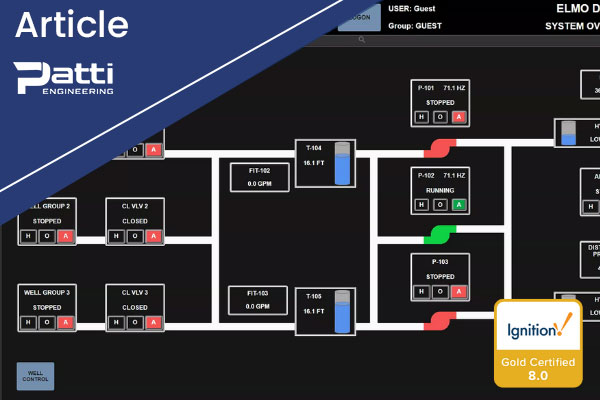
Why Ignition Is Growing On Us
Since deciding to join the Ignition certified integrator program and investing in training, our engineers have really grown to like Inductive Automation’s SCADA platform, Ignition. Our engineers have been finding many different use cases that take advantage of everything that the SCADA platform has to offer from distributed HMIs for assembly lines, to plant floor OEE systems, to customized lot tracing systems, as well as edge devices that can tie plant floor equipment and data directly to databases (whether they are on premises or are cloud based). The modern architecture and protocols that Ignition offers has allowed our engineers to come up with solutions to many different problems that our customers face.
“It’s a nice mix between web design and industrial programming,” said Jeff Watts, controls engineer. Here are some of our favorite aspects of the Ignition product.
- Modular Licensing – The base user licensing covers the basic features of Ignition. Additional licenses can also be added and/or removed at any time, which makes it easier to adjust the functionality of the system as its requirements change.
- One-Size Licenses – The tag or client licenses, with a few exceptions, are not tiered for different uses. With the all or nothing approach, we do not need to worry about purchasing a license that is too big or too small.
- Active Development – The Ignition product is still being actively developed which lends well to bug fixes, new features and support.
- Software Scripting Access – Having access to scripting allows us to create additional functionality that is not already a built-in feature. This helps to customize the application to suite our customer’s needs.
- Ease of Use – With the easy-to-use programming platform, we are able to implement quick changes and test the system live during software development and installation.
- Connectivity – Ignition is able to easily connect to PLCs, databases, MES systems, etc.
Recently we completed a project for the City of Fair Oaks Ranch. As a longtime customer, Fair Oaks Ranch reached out to help upgrade their servers from Windows 7 to Windows 10. During the proposal process, it was decided to transition the previous SCADA software to Ignition as the Ignition software was able to offer a better solution. Here are some highlights of the project.
- The screens that the users interacted with on a daily basis were able to be replicated, so the users saw really no difference in the new system.
- Most of the major changes were made to the back-end, which made a difference for the Patti Engineering support team and the Fair Oaks IT and security departments.
- One of the back-end changes was utilizing MQTT modules for communication from the distributed plants back to city hall. This reduced bandwidth usage which is currently going over cell routers. This can end up reducing data usage and cost for the city.
- The IPC hardware at Fair Oaks was completely replaced allowing us to program the new hardware in our office prior to the install. All other local controls hardware was left the same.
- The downtime for the upgrade was only during the physical installation of the new hardware.
- We were able to implement report generating so that the customer no longer had to go from station to station to hand-record daily data.
- The interface was upgraded with better graphics making it feel more like a webpage than an HMI screen. This also allowed us to create a mobile version for the customer to check-in remotely. We also implemented responsive screens that were equally user friendly on either a PC or a mobile device.
- The Ignition modular licensing reduced the price of the solution.
For more information about whether Ignition could be a good solution for you, contact us.
Related categories: Blog Control Systems Integration Ignition


